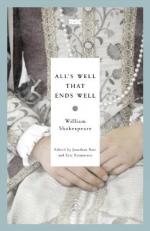|
This section contains 9,193 words (approx. 31 pages at 300 words per page) |

|
SOURCE: "Power and Virginity in the Problem Comedies: All's Well That Ends Well," in Broken Nuptials in Shakespeare's Plays, Yale University Press, 1985, pp. 58-104.
In the following excerpt, Neely argues that as a "problem play, " an often corrupt sexuality, rather than romantic love, drives action and informs imagery, language, character, and plot of All's Well That Ends Well.
In the problem plays, . . . there are no male disguises for the heroines, no green worlds, no fairies, no parody couples to express desire and protect the main couples; even the bawdy is changed in tone. Sexuality is now frequently dissociated from marriage and procreation. It finds expression in seduction (Troilus and Cressida and All's Well), aggressive lust (Measure for Measure), prostitution (Measure for Measure, Othello), promiscuity (Troilus and Cressida), and, perhaps, adultery (Hamlet). Instead of being connected with imagery of growth and fertility, sexuality is associated with corruption, loss, disease...
|
This section contains 9,193 words (approx. 31 pages at 300 words per page) |

|


